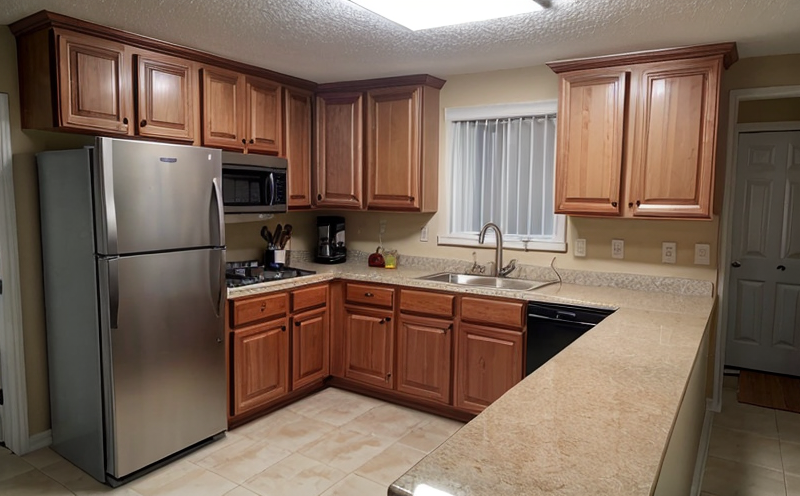Kitchen hygiene inspection
The kitchen hygiene inspection is a critical component in ensuring food safety and compliance with regulations that protect public health. This service evaluates the cleanliness of kitchens to prevent contamination, which can lead to foodborne illnesses such as salmonella, listeria, and E. coli. The primary goal is not only to meet regulatory requirements but also to ensure operational efficiency and customer satisfaction.
Food safety inspections focus on several key areas: personnel hygiene practices, proper handling of raw materials, storage conditions, cleaning procedures, pest control measures, and the overall cleanliness of equipment and surfaces. Regulatory standards such as ISO 22000 and HACCP (Hazard Analysis and Critical Control Points) provide frameworks for these inspections.
The inspection process typically involves a thorough visual examination of all areas within the kitchen, including preparation zones, storage facilities, dishwashing stations, and waste disposal units. Microbiological sampling may also be conducted to detect pathogens that could compromise food safety. The results are then reported back to management so they can address any deficiencies identified during the inspection.
By adhering strictly to these practices, businesses demonstrate their commitment to maintaining high standards of cleanliness and hygiene in the kitchen environment. This dedication helps build trust with customers who value transparency regarding how their meals are prepared. Moreover, it ensures that all operations comply fully with relevant legislation and industry best practices.
In today’s competitive market, demonstrating superior levels of food safety and hygiene becomes increasingly important for attracting new clients while retaining existing ones. A well-executed kitchen hygiene inspection not only mitigates risks associated with contamination but also fosters positive relationships between suppliers, distributors, and end consumers.
Why Choose This Test
Selecting a reputable laboratory for conducting kitchen hygiene inspections offers numerous benefits that go beyond mere compliance. First and foremost, experienced professionals can provide insights into best practices tailored specifically to your business needs. They understand the nuances of different industries and know exactly what standards should be met.
Regular inspections help identify potential hazards early on before they escalate into major issues. Early detection allows for prompt corrective actions which save time and money in the long run compared to dealing with outbreaks or recalls later down the line. Additionally, consistent monitoring ensures continuous improvement towards achieving optimal performance levels consistently over time.
A certified laboratory guarantees accuracy and reliability of results through rigorous quality assurance processes. Independent third-party verification lends credibility to your operations by showing that you are committed to maintaining high standards even under scrutiny from regulators or internal audits.
The peace of mind derived from knowing that your kitchen meets all necessary criteria gives you the confidence needed when interacting with customers, suppliers, and other stakeholders involved in food production chains. It also enhances brand reputation which ultimately translates into better sales prospects and higher customer loyalty rates.
Customer Impact and Satisfaction
Implementing robust kitchen hygiene inspection protocols has a direct impact on customer satisfaction by ensuring they receive safe, high-quality meals every time. When diners know their food is prepared under strict hygienic conditions, it builds trust in the establishment’s reputation.
Consistent adherence to good manufacturing practices (GMP) and other relevant standards instills confidence among consumers about the quality of products being served. This leads to greater customer satisfaction and loyalty as patrons feel assured that their orders will be handled safely from start to finish.
From an operational perspective, effective kitchen hygiene inspections contribute positively towards reducing waste, minimizing cross-contamination risks, and improving overall efficiency within food processing facilities. By identifying areas needing improvement early on, managers can allocate resources more effectively leading to cost savings without compromising safety standards.
The benefits extend beyond just immediate stakeholders; a clean kitchen environment promotes better health outcomes for both employees and customers alike by reducing the incidence of foodborne illnesses. This positive outcome contributes significantly towards maintaining public confidence in your brand reputation which is invaluable asset especially during challenging economic times when consumer spending power may be limited.
Competitive Advantage and Market Impact
In today’s competitive landscape, offering exceptional kitchen hygiene inspection services can give businesses a significant edge over competitors who might not prioritize this aspect as much. By demonstrating excellence in food safety practices, establishments set themselves apart from others by providing superior service quality.
A strong commitment to cleanliness and sanitation reflects positively on the overall image of the company, making it more attractive to potential customers looking for reliable providers. Potential investors are also likely impressed by such initiatives since they indicate sound management practices aimed at long-term sustainability rather than short-term profits alone.
The growing trend towards healthier eating habits coupled with increased awareness around food safety has created new opportunities for businesses focused on delivering safe products consistently. For example, organic restaurants or those catering exclusively to health-conscious consumers could leverage these services as selling points that differentiate them from traditional counterparts.
Moreover, implementing advanced technology solutions like real-time monitoring systems can further enhance operational efficiency while minimizing manual errors during inspections. Such innovations not only improve accuracy but also reduce downtime allowing for faster turnaround times between assessments.





